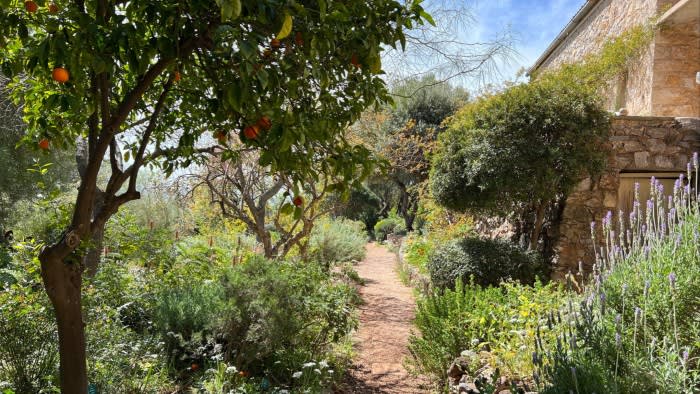I have just made a good call. Two weeks ago, the English weather relapsed into yet more days of rain, puddles and greyness. Crocuses keeled over and I had no wish to be working at ground level while rain dripped down my neck. I decided to escape to the other end of the horticultural spectrum, to gardening in a Mediterranean manner. I was anyway booked for a lecture in Athens, where the garden of the Mediterranean Garden Society lies at Sparoza, on the outskirts (sparozagarden.com, for booked tours only). Why not spend time there too, limbering up before lecturing on ancient history?
Leaving my aconites to dry out, I stepped into another season. Accelerated springtime is a magical experience. The dark blue flowers on teucrium appear in Britain in May but in Greece they were buzzing with pollinating bees. Double-pink flowers proliferated on Rose Duchesse de Brabant. She is not to be confused with Honorine de Brabant, an older rose with dark streaks on lilac-pink flowers. The Duchesse is too seldom seen in Britain, though she repeats her pink flowers during the summer. This February, in Athens, she banished memories of battered crocuses, as did roses on other Sparoza favourites, pink Champion of the World and red Cramoisi Supérieur, excellent choices for dry gardens.
Sparoza’s head gardener, Lucie Willan, has been in charge for three years. She has reinforced whole areas of the garden, despite changes in the seasons that are as abrupt as our British non-winter. While I admired the fleshy green leaves and yellow heads of flower on her Bulbine frutescens, a fine plant from South Africa, not hardy for us, she called me over to admire an iris on her plant stall, propagated in the garden, and an orchid in full splendour which she wanted me to smell. Neither would be seen in flower in Britain, let alone in February.
At home I grow the snake’s head iris, Iris tuberosa, with long grassy leaves and flowers in a blend of green and black. Willan proudly showed me the first flowers on a fresh yellow variation, one that grows rarely on hillsides in Greece. It is heavenly. She then pointed me to spikes of flower on Himantoglossum robertianum, an orchid that she tends beside low shrubs. Orchids outdoors in February upset my innate calendar, but she told me to smell them. Crawling clumsily, I found they have a sweet scent suggesting violets.


We moved further into the garden to see how its seasons and cultivation differ from Britain’s. It is fashionable, but mistaken, to say that English gardens are becoming Mediterranean. As the weather changes, the winters are warmer, usually. In 2022 summer temperatures briefly hit new highs, but “Mediterranean” Britain is a myth. Last summer was mostly cool, broken with cloud and showers. This winter has been exceptionally wet and un-Mediterranean since mid-December. At Sparoza, by contrast, there has been no rain since mid-December, when a hail storm pockmarked the leaves of the cactussy agaves.
Like British weather, Mediterranean conditions are changing, forcing gardeners to change too. In each of Willan’s years at Sparoza, summer heat has been intense and rain unusually scarce, despite novel downpours in July. She points to losses of trees and explains that a Mediterranean style needs to widen its range of plants and include African and even Californian alternatives.
Britain does not have a similar growing season. Our roses are never freshly out in February and our annuals are best sown in spring, whereas annuals in a Mediterranean year are best sown in autumn to flower by May. For Brits, Mediterranean gardening is topsy-turvy. Its lessons for them are more general: how to cope with drought and how to vary heights, shadows and cover.
In Britain, mulching, applied this month, will make excellent sense. The ground is very wet and the damp can be conserved by a thick layer of rotted leaves, compost or even plain straw. In gardens by the Mediterranean, we agreed that thick mulching with such material is less valuable and that a dressing with pea gravel is a better way forward. The gravel remains damp deeper down, retaining moisture on its outer coating. It is not a rich fertiliser.
As we discussed gravel, I admired one of Willan’s top recommendations for frost-free gardens, the lovely chasmanthe, whose yellow, orange or scarlet flowers resemble tall crocosmias. Corms are sold in spring in Britain, so I will try them in a pot, but they cannot be left in the ground in winter. At Sparoza they survive and, as South African natives, illustrate the wisdom of widening a “Mediterranean” palette.
In Britain, my garden is still bare and bleak. At Sparoza, some of February’s charm is the interplay of light and green shade, patterning the views through low shrubs above carpets of iris and blue Muscari commutatum, our grape hyacinth. Rosemary is prominent in the effect, the selected Tuscan Blue variety to the fore, one which the winter of 2022-23 killed in Britain. By the paths, pink and white cyclamen delighted me too, the persicum cyclamen, which is a Greek native despite its “Persian” name. In Britain it is not hardy. It is a parent of what Willan calls the “monsters”: the cyclamen we give at Christmas and usually kill indoors within three months.


On the hillside, we marvelled at low clumps of a dark-flowered fritillary, obliqua, and at groups of true Mediterranean fennel with chunky stems, the ones that were waved by ecstatic followers of the Greek god Dionysus. They are particularly fine, Willan has noted, near the ancient temple at Attica’s Sounion but “on the west coast, best of all”.
In the foreground, thick green leaves were sprouting from bulbs as big as croquet balls, known as Urginea or, recently, Drimia. They have long foxtails of white flower in summer. I looked in wonder, because the bulbs tie up with a thread in my year so far. I have been tussling weekly with the greatest of all early Arabic poems, composed by that wandering genius of a poet, Imru’ al-Qais, in the sixth century AD, in the Arabian peninsula before Muhammad. It is loved by well-schooled Arabic speakers, but is challenging, even for them, with its old vocabulary and range of compressed allusions.
The poem begins with the speaker stopping to lament old traces of a best-beloved, still visible in the desert sand. It ends with a magnificent account of a storm which is breaking across the landscape, leaving animals dead like “uprooted flower bulbs” on the sand. What bulbs, I wondered? A translator renders them as squills. They are not the blue-flowered little scilla-squills whose flowers are opening in British gardens. They are big sea squills, native indeed in the south Arabian Desert.
In ancient Athens, contemporaries mocked the great politician Pericles for having a head shaped like a squill. It was not a pointed head, as many have misunderstood, but a rounded bald head like a sea squill’s big rounded bulb. How apt that on an Athenian hillside I should fully appreciate it and grasp the Arabic poet’s exact image, bulbs of sea squills, not under the sand but on the surface where they sit, like Sparoza’s, grounded only by storm-susceptible roots. Britain’s rain-sodden crocuses seemed very far away.
Find out about our latest stories first — follow @FTProperty on X or @ft_houseandhome on Instagram
Also Read More: World News | Entertainment News | Celebrity News







